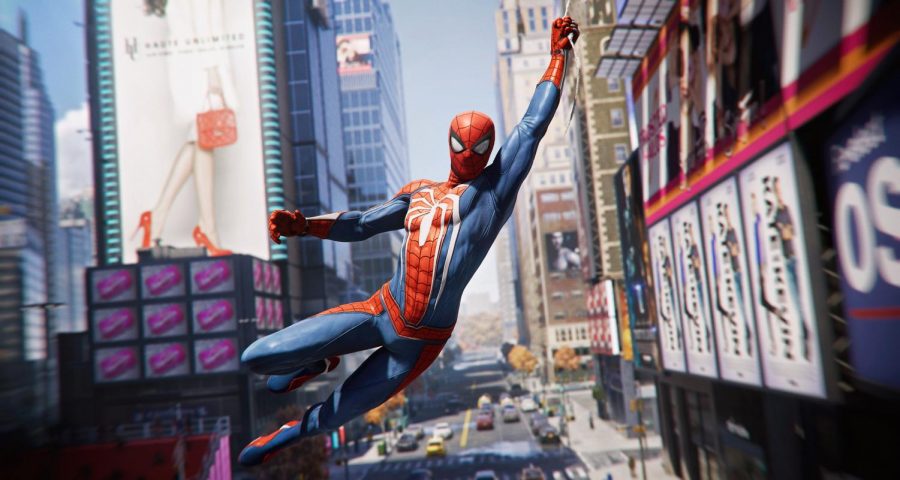Review: Spider-Man PS4
Insomniac Games’ “Spider-Man” is a masterful balance between fun gameplay and an engaging story that’s sure to please everyone from casual players to hardcore fans.
Like many others, I’ve spent the last week playing Marvel’s Spider-Man. I’d been anticipating this title for the last two years—developer Insomniac’s initial announcement was made at E3 2016—and I’m glad to say that the game was everything I’d hoped for and more.
 The first thing that caught my eye about Spider-Man was the sheer grandiosity of its open world—New York has likely never looked so good in a video game. Overlooking the city from a vantage point like the Avengers Tower or Empire State Building is legitimately breathtaking, and I could easily tell that a lot of work went into the game to make its city feel alive. Despite the game’s inclusion of a fast-travel system to traverse to different parts of the map, I never found the need to use it—seeing everything in the city as you swing along is a gratifying enough experience to justify spending a little bit more of your time getting somewhere. Of course, a beautiful open world means nothing if your means of transportation isn’t worth using, but this isn’t the case with Spider-Man. The controls are incredibly intuitive, and there are so many fun ways to get around the city that aimlessly swinging before starting the next part of the story is an activity that can be done for hours on end before getting bored. It’s clear that the game wanted to promote a constant sense of movement, as it’s possible to leap from building to building without losing any speed at all; players who enjoy a challenge can try to keep up their momentum from one end of the city to another.
The first thing that caught my eye about Spider-Man was the sheer grandiosity of its open world—New York has likely never looked so good in a video game. Overlooking the city from a vantage point like the Avengers Tower or Empire State Building is legitimately breathtaking, and I could easily tell that a lot of work went into the game to make its city feel alive. Despite the game’s inclusion of a fast-travel system to traverse to different parts of the map, I never found the need to use it—seeing everything in the city as you swing along is a gratifying enough experience to justify spending a little bit more of your time getting somewhere. Of course, a beautiful open world means nothing if your means of transportation isn’t worth using, but this isn’t the case with Spider-Man. The controls are incredibly intuitive, and there are so many fun ways to get around the city that aimlessly swinging before starting the next part of the story is an activity that can be done for hours on end before getting bored. It’s clear that the game wanted to promote a constant sense of movement, as it’s possible to leap from building to building without losing any speed at all; players who enjoy a challenge can try to keep up their momentum from one end of the city to another.
The combat in Spider-Man is fluid and dynamic, and the implementation of a gadget wheel like in 2016’s Rachet and Clank—in which you can switch between different weapons to use during a fight—feels natural. Though the rhythm-based combat takes clear inspiration from Rocksteady’s Batman: Arkham series, Insomniac adds a twist to it: unlike Batman, this game’s hero isn’t a bulky bruiser; therefore, he can’t take quite as many hits before he falls. This means that players will have to be slightly more strategic with how they approach fights in this game, as even taking two to three shots from sniper fire means game over.

The Spider-Man we play as in the game isn’t the Peter Parker you may be used to; this one, unlike versions present in comic books or even the more recent Spider-Man: Homecoming, is 23 years old. This is significant—by making this game’s Spider-Man older, Insomniac set itself apart from convoluted backstories and side-stepped the historical baggage that writing a story starring such an iconic character naturally comes with. Despite not being able to see the seven years of experience that separates the Spider-Man you’re probably familiar with and this game’s protagonist, little things like referring to his villains by their first names or finding old backpacks throughout the city give this character—and his world—a real sense of continuity. This isn’t to say that this is a completely different Spider-Man than the ones from the comics or Spider-Man: Homecoming, though; players will surely recognize his wry wit and characteristic one-liners.

The duality of the two lives Peter Parker leads—from the intensity of dodging bullets to the mundanity of overdue rent—is a key theme throughout the story, and players should expect to spend just as much time with him as his web-swinging alter ego. These parts of the game give the plot far more nuance than any of Spider-Man’s previous video game outings, as it introduces a new layer of the protagonist’s personality that’s never really been explored before. They come in the form of short interludes between more intense Spider-Man segments where you play as Peter Parker, his on-and-off girlfriend Mary Jane Watson, and Peter’s newfound ally Miles Morales; though some players had qualms with how this interrupted the flow of the story, I personally thought it was a good way to give the plot more depth. This is also another way that Insomniac separated its own game from the plethora of other superhero titles from the past few years—namely the aforementioned Batman: Arkham series—and made the game a unique experience to play through.
Outside of the main story, there’s a lot to do—after hacking surveillance towers around the open world to unlock different parts of the map, the game gives you tons of side missions to finish. Though some of these missions amount to fetch-quests and can get incredibly repetitive, it’s recommended to spread them throughout your playthrough to make them more tolerable; luckily, it never got to a point where I didn’t want to do them.
I had very high expectations for Spider-Man from its first announcement from E3 2016, and while the game isn’t perfect—some boring side missions with little variability drag the experience down—it’s easily one of the best games to come out this year, and undeniably the definitive Spider-Man video game experience. A second Spider-Man after this one’s commercial success is a no-brainer, and I’m excited to see what Insomniac does with this unique universe moving forward; hopefully, it delivers a sequel that was just as much fun gameplay and story-wise as this one was.

Aiden Kwen ('20), Senior Editor, is interested in interactions between pop culture and social issues; as the president of the Controversy Club at THS and...


















































































































































